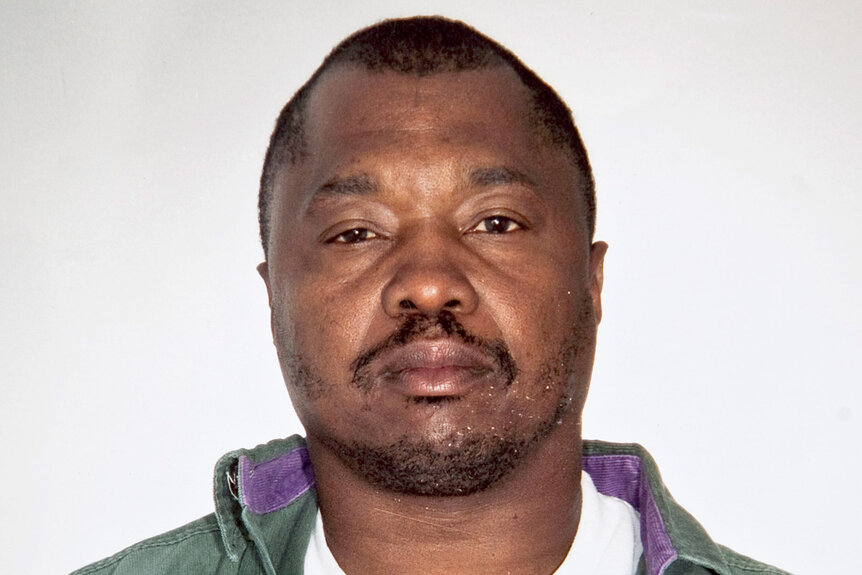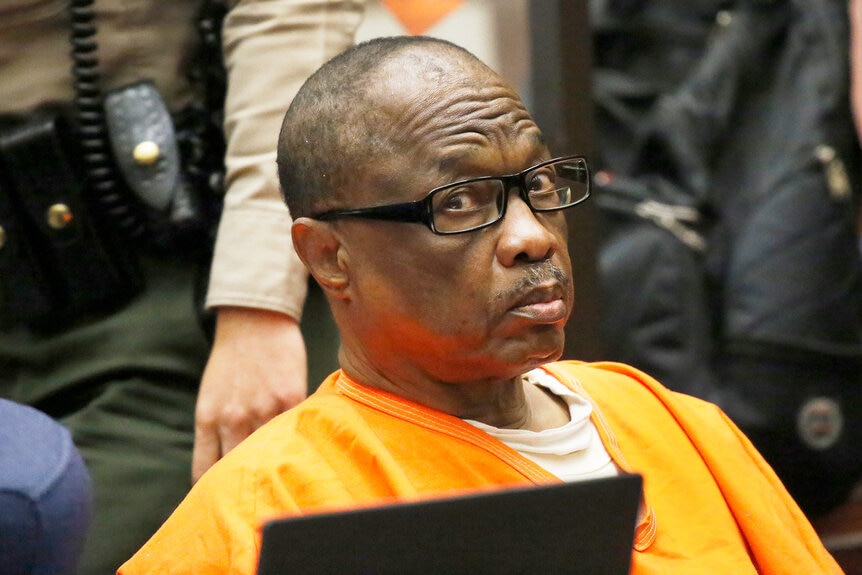Create a free profile to get unlimited access to exclusive videos, breaking news, sweepstakes, and more!
How DNA Helped Catch The ‘Grim Sleeper,’ The Prolific Serial Killer Who Terrorized Los Angeles
While hunting the “Grim Sleeper,” investigators turned to a new and controversial technique — familial DNA matches.
Murders A-Z is a collection of true crime stories that take an in-depth look at both little-known and famous murders throughout history.
For more than 20 years, serial killer Lonnie David Franklin Jr. stalked the backstreets of South Central Los Angeles, raping and murdering young Black women. Operating at the height of the crack epidemic, he got away with at least 10 murders before going underground for more than a decade.
When he returned to his killing ways, he was largely ignored until the magazine LA Weekly broke the story in 2008, dubbing him “The Grim Sleeper” for his 13-year absence. If it were not for breakthroughs in DNA technology, he might've gotten away with his crimes for good.
RELATED: Mall Santas, Babysitters, Ice Cream Men — Serial Killers Who Worked Creepy Day Jobs
Here's what you should know about "The Grim Sleeper"...
The Grim Sleeper Lonnie Franklin Jr.
Born in 1952, Franklin grew up in the same neighborhoods where he hunted for victims. Historically the home of Los Angeles’ Black community, South Central earned a poor reputation in the 1980s due to escalating gang activity and drug problems. With murder rates on the rise, it was the perfect climate for a serial killer to hide in plain sight. In 2003, the city would change its name to “South Los Angeles,” in order to distance itself from those troubled times.
To friends and neighbors, Franklin seemed like a regular guy with a wife and two kids, reported The Los Angeles Times. He was a good mechanic, who fixed his neighbors’ cars on the cheap, and at one point, he even worked as a garage attendant at the LAPD’s 77th Street Division station nearby. Despite his friendly demeanor, he had an arrest record and a history of sexual violence going back to the 1970s, according to the Times.
In 1974, while stationed in Stuttgart, Germany, as a private in the U.S. Army, Franklin and two other men kidnapped and raped a 17-year-old girl. During the attack, the soldiers took photographs of the attack, an action that Franklin would repeat when he began killing women in the 1980s, reported Los Angeles’ ABC 7. The three were arrested and charged with two counts of theft, one count of misdemeanor assault and one count of battery. Franklin was sentenced to about three years in prison, although he would serve less than a year. He also received a general discharge from the Army, according to People magazine.
“We don’t know why he got out,” LAPD detective Daryn Dupree told the outlet in 2016. “The other guys did their whole time.”
Lonnie Franklin's Victims
In August 1985, Franklin claimed the first of his known victims, 29-year-old Debra Jackson. She was shot three times in the chest and her body was dumped in an alley, according to the Los Angeles Times. Over the next three years, he would kill six more women — Princess Berthomieux, Valerie McCorvey, 25; Janecia Peters, 25; Henrietta Wright, 35; Barbara Ware, 23; Bernita Sparks, 26; Mary Lowe, 26; Lachrica Jefferson, 22; and Alicia “Monique” Alexander, 18 — shooting them in the chest and often dumping their bodies in alleys, in some cases covering them with trash. Many of his victims had been beaten and raped.
Some of Franklin’s victims suffered from drug addiction and occasionally did sex work to support their habits, reported the Los Angeles Times. Police said Franklin initiated sexual content with his victims before murdering them, according to The Washington Post.
At the same time of Franklin’s murderers, there were multiple serial killers active in South-Central Los Angeles, including Nightstalker Richard Ramirez. Their combined crimes were thought to be the work of a single murderer, known as the “Southside Slayer.” It would be decades before law enforcement realized these were 4 or 5 different killers, according to ABC News.
Why Is Lonnie Franklin Called the Grim Sleeper?
Following the November 1988 rape and attempted murder of Enietra Washington — his only known survivor — Franklin’s trail went cold. It would be 13 years before his next known murder, hence his name.
Investigators, however, doubt he was as inactive as his nickname suggests.
“I don’t think he stopped killing,” LAPD Detective Daryn Dupree told the Los Angeles Times, while Detective Dennis Kilcoyne, who also worked the case, told The Daily Beast, “We know he wasn’t sleeping.”
In March 2002, the nude body of Princess Berthomieux, 15, was found in an Inglewood alleyway, beaten and strangled. Seventeen months later, 35-year-old Valerie McCorvey’s body was found in an alley. She had been sexually assaulted and strangled.
DNA found on their bodies was tested and linked them to the murders of the 1980s, reported The Daily Beast. Though police were horrified to realize the killer was back in action, they were hopeful advances in forensic technology would afford them the opportunity to stop him once and for all.
Traces of the killer’s dried saliva were found on many of his victims’ breasts, according to LA Weekly. Unfortunately, no matches were found when they ran this DNA profile through state and federal offender databases. Ironically, Franklin had been arrested numerous times for offenses like assault, battery and receiving stolen property, according to the Los Angeles Times. His arrests occurred, however, before voters in California approved a measure that required DNA be taken from all felony convictions.
Franklin claimed one final victim in 2007 — Janecia Peters, 25, who was found in a garbage bag in an alley off Western Ave. — before the LAPD quietly assembled a task force to investigate the connected murders from the 1980s and 2000s.
How The Grim Sleeper Was Caught
Unable to identify the killer outright, they turned to a new and controversial technique — looking for matching “familial” DNA markers in their databases that would indicate a possible relative of the suspect already in the system.
LA Weekly described law enforcement’s efforts to bring him to justice in “Grim Sleeper Returns: He’s Murdering Angelenos, As Cops Hunt His DNA,” giving the killer a moniker. According to the 2008 piece, “The Grim Sleeper” was the longest-operating serial killer west of the Mississippi.
Finally, after more than two decades, investigators made a break in the case with unintentional assistance from Franklin’s son, Christopher, who was convicted on a felony weapons charge in 2009. During his incarceration, a DNA sample was taken. Shortly thereafter, the LAPD ran another “familial” DNA search. Police told LA Weekly that Christopher’s DNA matched in so many ways, they knew he was a close relative of The Grim Sleeper.
Lonnie Franklin Jr., Christopher’s father, soon emerged as the prime suspect. Starting in July 2010, an undercover surveillance team began watching Franklin’s every move, according to the Los Angeles Times.
On July 5, Franklin was trailed to a family birthday party at a pizzeria in Orange County. A detective disguised as a busboy collected a half-eaten slice of pizza, a fork, two napkins, two plastic cups and a piece of chocolate cake from Franklin’s table, according to the Los Angeles Times. They were then rushed to the LAPD’s DNA lab for testing.
His DNA was a match for the samples found at The Grim Sleeper crime scenes. On July 7, police arrived at Franklin’s South Los Angeles home to take the 57-year-old serial killer into custody. He was charged with 10 counts of murder and one count of attempted murder, according to the Los Angeles Times. Police would find the gun that killed Janecia Peters and numerous Polaroids of his victims during a search of his residence, according to Time.
In May 2016, Lonnie Franklin Jr. was found guilty of 10 counts of first-degree murder, and one count of attempted murder, according to The New York Times. DNA evidence featured heavily in his two-month trial and, along with ballistic evidence, linked him to each of the 10 murder victims.
Franklin was sentenced to death by lethal injection on Aug. 10, 2016, following the recommendation of jurors who chose the death sentence over life in prison without parole, according to Reuters.
How Did Grim Sleeper Lonnie Franklin Die?
Franklin was found dead in his prison cell at California's San Quentin State Prison in March 2020, the California Department of Corrections announced in a statement. The 67-year-old seemingly died of natural causes, with the statement noting there were "no signs of trauma."
For more cold case investigations, follow Paul Holes as he explores the physical and emotional "DNA" of crime scenes in The DNA of Murder with Paul Holes, streaming on Oxygen.com.
(This article was originally published on September 18, 2019. It was updated on May 23, 2023.)




































